| home > report on operations > financial position > review of balance sheet, income statement and financial position |
home > report on operations > financial position > review of balance sheet, income statement and financial position
review of balance sheet, income statement and financial position
Income Statement
The Income Statement of the Parent
Company for financial year 2012
recorded a net loss of 245.7 million
euros, against a net profit of 39.3
million euros for financial year 2011,
mainly determined by the strong and
unexpected reduction of advertising
revenues (-209.0 million euros) and the
costs of big sports events.
As reported in greater detail further
ahead in this report, the 2012 result
benefits from a positive component
equating to 20.5 million euros deriving
from the adoption, as of this year, of the
valuation of investments at equity,
instead of evaluation at cost adopted
until 31 December 2011.
The reasons for this change arise from
the need to offer a better representation
of the financial and earnings situation
along with the results of operations and
to increase the consistency of the
Company’s equity, aligning equity
figures with those of the consolidated
financial statements.
This change also determines the
booking of a Shareholders’ equity
reserve of 112.1 million euros, by effect
of the change in principle adopted until
31 December 2011.
The following section provides an
overview of the main items of the
Income Statement and the reasons
behind the more significant changes
from the previous year.
Revenues from sales and services
Revenues from sales and services consist
of licence fees, advertising revenues and
other commercial revenues.
They totalled 2,625.5 million euros,
down 199.3 million euros (-7.1%) on
2011.
Licence fees (1,747.8 million euros).
These include licence fees for the
current year as well as those for
previous years, collected through coercive payment following legal
registration.
The overall increase (+2.3%) refers to the
increase in the per-unit licence fee from
110.50 euros to 112.00 euros (+1.4%)
and to the increase in the number of
paying subscribers due to the significant
growth in new subscribers compared to
the number of new subscribers in 2011
(506,486 units, +26.0%) capable of
offsetting the rise in cancellations and
arrears, or of the number of subscribers
entered in the list of debtors who have not
paid their licence fee.

Once again in 2012 the licence fee
paid in Italy continues to be one of the
lowest in Europe.
By way of example, the table shows the
annual licence fee, in euros, in force in
selected European countries.
Advertising revenues.
In a framework
characterised by the deceleration of the
economy and the drop in consumption,
advertising revenues in 2012 also
recorded evident signs of difficulty.
The Nielsen figures, while failing to
allow a fully standardised comparison
due to the fact that changes have been
made in the setting in which data is
measured, show a 14.3% contraction in
the advertising, affecting all media,
apart from the Internet, which closed at
+5.3%. Television and radio advertising
investments in particular show a decline
of 15.3% and 10.2% respectively.
In this context, Rai’s advertising
revenues (674.9 million euros) highlight
a reduction of 209.0 million euros
(-23.6%) compared with 2011, as
shown in the table to the right.
The drop in advertising revenues was
higher than the contraction of the
reference market, determining a
considerable loss of the market share by
the Rai concession holder during the
year. To offset this, incisive actions were
taken to intervene on the various
corporate areas of Sipra, including a
review of commercial practices and a
strengthening of the managerial layout
and of in-house procedures.
It should be noted that revenues from
advertising on specialised channels
continue to grow (+3.7 million euros,
+9.0%).
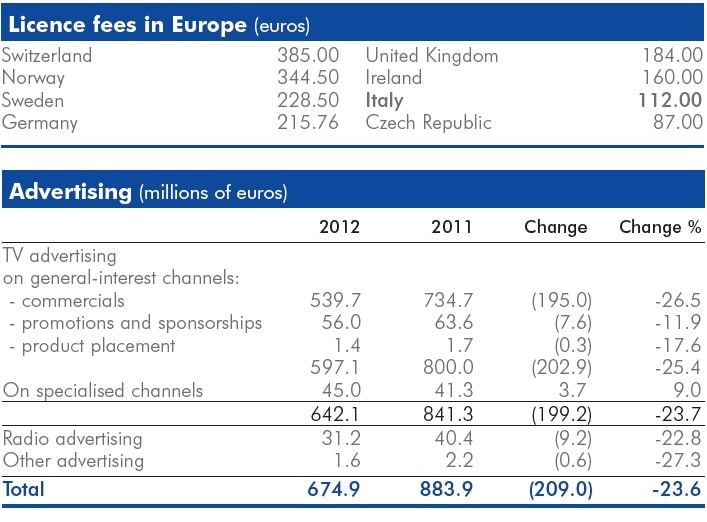
Other revenues present a reduction of
29.7 million euros (-12.8%), as
highlighted in detail in the table to the
right.
The reduction is determined mainly by
the drop in the Special services under
agreement item (-22.3 million euros),
resulting largely from reduction of
amounts provided by the Presidency of
the Council of Ministers to 50%
compared to that envisaged for the
previous year and by the Sale of rights
to utilise materials to football clubs item
(-7.6 million euros), the reduction of
which is due to different agreements
entered into during the two years.
Due to the advertising crisis and
because of the reduction of other
revenues, as indicated in the table to
the right, revenues from licence fees
represent two thirds of overall income.
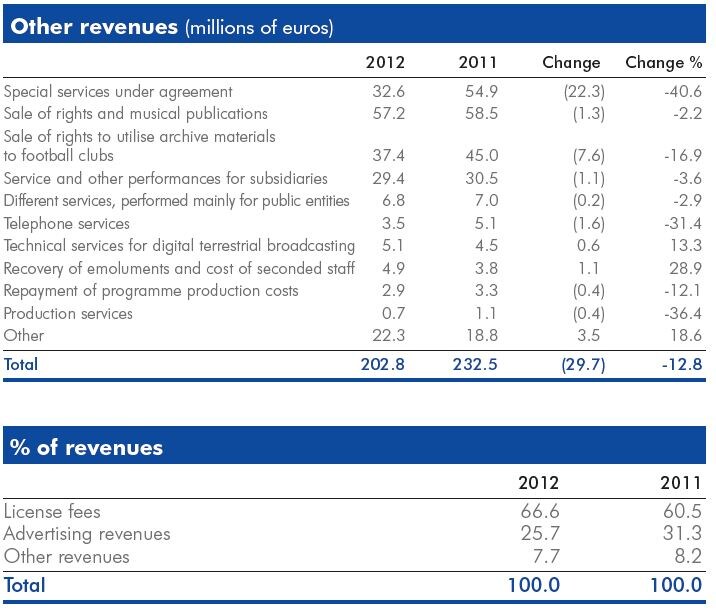
Operating costs
The item includes internal costs (labour
cost) and external costs, regarding
ordinary business activities.
These total 2,535.2 million euros, up
18.1 million euros, (+0.7%), compared
with 2011, the reasons for which are
listed below.
Consumption of goods and external
services – This caption includes
purchases of goods and services
required to make programmes of
immediate use (purchases of
consumables, external services, artistic
collaborations, etc.), filming rights for
sports events, copyright, services from
subsidiaries, running costs (rental and hire fees, telephone and postage costs,
cleaning, maintenance, etc.) and other
operating costs (direct and indirect
taxes, contribution to the Authority, the
public broadcasting concession fee,
etc.).
Compared with the previous year, the
item shows an increase of 30.8 million
euros (+1.9%), due to the presence
during the year of costs related to fouryearly
sports events (European Football
Championship and Olympic Games) for
143.0 million euros (including costs for
the production of these events
amounting to 8.1 million euros).
Net of this component, there was a net
reduction of about 110 million euros in
external costs compared to 2011, determined largely by initiatives
implemented during the year to contain
spending.
The table on the following page shows
details of savings in most items, apart
from filming rights which presents an
increase of 97.5 million euros for the
reasons already disclosed.
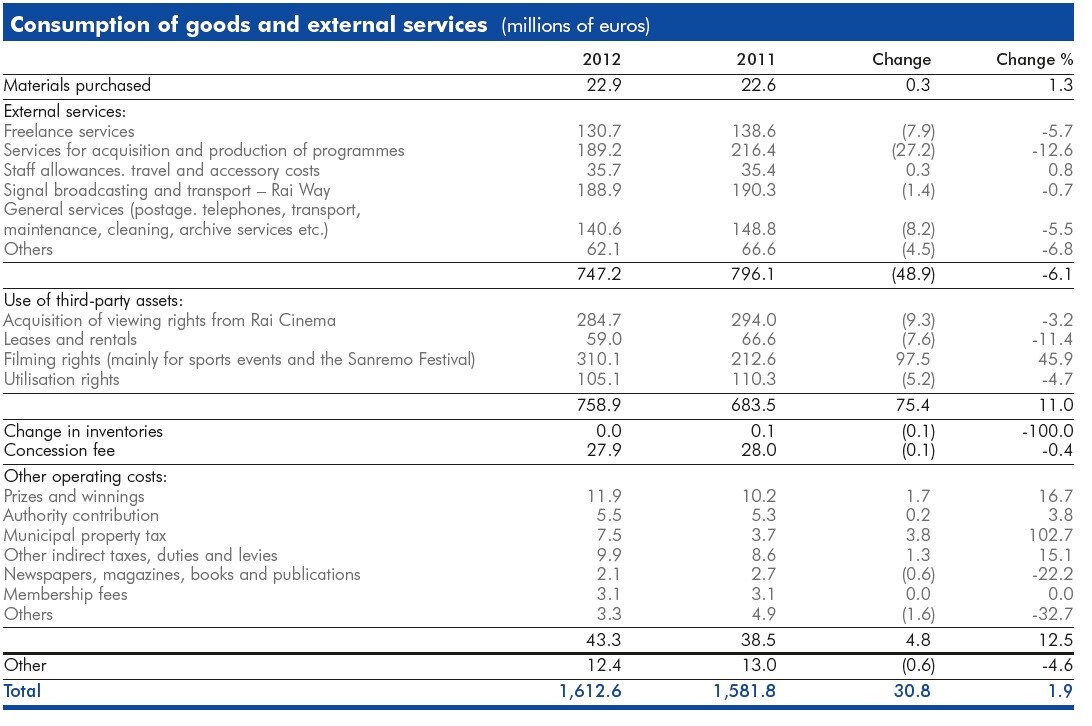
Personnel costs – These amount to
922.6 million euros, down 12.7 million
euros on the total at 31 December
2011 (-1.1%), according to the
breakdown in the table to the right.

The reduction in personnel costs is
determined mainly by the provision of a
bonus system for employees, about 19
million euros lower than that assigned in
the previous year.
Net of the phenomenon mentioned
above, personnel costs presented a
modest increase (about 6 million euros)
due to the positive effects of incentives
in 2011 which offset the physiological
growth in personnel costs as a result of
contractual automatic pay increases and
the impact of the renewal of the
collective labour contracts.
Lower inflation also positively influenced
the trend of personnel costs, having a
positive impact on the revaluation of the
provision for staff severance pay and the
continuation, once again in 2012, of
the substantial blockage of payment
policies.
Personnel on payroll at 31 December
2012 amounted to 10,476 units, up
280 on 31 December 2011.
The average number of employees,
including those on fixed-term contracts,
came to 11,851, with an increase of 22
members of staff compared to last year.
In details, there has been a drop of 214
members of staff on fixed-term contracts
following the final hiring of staff on
temporary contracts and an increase of
236 members of staff on permanent
contracts.
Gross Operating Margin
The Gross Operating Margin, as a
consequence of the above, is positive by
106.9 million euros, down 214.9
million euros, or -66.8%, on the
previous year.
Amortisation of programmes
This caption is related to investments
in programmes, which during 2012
amounted to 233.1 million euros, down
22.2 million euros (-8.7%), largely for
TV fiction series.

Amortisationcharged to the above
captions for the year, 217.4 million
euros, shows a reduction of 22.9
million euros compared with the
previous year (-9.5%) related to the
trend in investments.

Other amortisation
The 2012 movement in this item, shown
in the following table, is linked to
investments in tangible non-current
assets and other investments, and
presents a total reduction of 44.5
million euros, largely determined by the
previous year’s acquisition of the DEAR
property complex for an amount of 52.5
million euros.

Amortisation and depreciation for the
period referring to the items mentioned
above amount to 68.8 million euros,
with a slight increase of 0.7 million
euros compared to 2011.
This substantial stability is due to the
offsetting effect between new
amortisation/depreciation due to
investments made during the year and
the reduction determined by the gradual
completion of the
amortisation/depreciation of assets
brought into use in past years.

Other net income (charges)
The item comprises costs/revenues not
directly related to the Company’s core
business and, in 2012, highlights net
expenses of 36.4 million euros (36.9
million euros in the previous year). In
detail, it comprises expenses for repeatusage
programmes which it is not
expected will be used, repeated or
commercially exploited (28.2 million
euros in 2011: 29.2 million euros),
provision for the company
supplementary pension fund for former
employees (12.0 million euros, in 2011:
13.8 million euros), provisions for risks
and charges (21.0 million euros, in
2011: 10.8 million euros), partially
offset by net contingent assets (20.5
million euros, in 2011: 18.1 million
euros) and the release of funds
allocated in previous years (10.3 million
euros, in 2011: 8.8 million
Operating Result
The performance described above for
operating revenues and costs led to a
reduction in the operating result, from
-23.5 million euros in the previous year
to -215.7 million euros this year, with a
deterioration of 192.2 million euros.
Net financial expense
Net financial expense shows a loss of
3.8 million euros (0.6 million euros in
2011). The item shows the economic
effects of typical financial operations
and comprises bank interest expense
and income as well as that relating to
Group companies and net gains in
relation to exchange rates.
The figures show an increase in net
interest payable to banks of 5.0 million
euros due to higher financial exposure
to third parties and an increase in the
average interest rates on loans.
Net intercompany positions, particularly
with Rai Cinema and Rai Way,
determined higher intercompany interest
income of about 7 million euros,
similarly to the previous year.
Exchange rate differences, mainly
generated by the acquisition of rights to
sports events in US dollars, were positive
and increased thanks partly to hedging
activities carried out in previous years,
which counteracted the fluctuations in
the euro/dollar exchange rate during
the year. Other financial expenses,
which grew modestly, deteriorated as a
result of higher bank commissions for
new loans.
The average cost of loans, consisting of
current account credit lines, ‘hot
money’, stand-by and medium-term
loans, settled at 3.4% (2.8% in the
previous year), up in relation to the
increased weight of fixed rate debts
compared to the previous year.

Income from equity investments
As indicated in the table on the
following page, the item amounts to a
total of 24.3 million euros.
As already highlighted, as of 2012
investments in subsidiaries and
associated companies are assessed
using the equity method instead of the
previous valuation method based on the
purchase cost adjusted in the event of
durable losses in value.
The equity method envisages that the
value at which investment is booked be
the same as the corresponding fraction
of the Shareholders’ equity resulting
from the last financial statements, minus
the dividends and after the adjustments
required by the principles used in the
preparation of the consolidated
financial statements.
The gain or loss by the investee
company for the year, duly adjusted, is
booked to the Income Statement in the
year to which the result refers.
Also, as 2012 is the year of first
application of said principle, the higher
values of the investments consequential
to the profits of previous years,
amounting to about 112 million euros,
were carried in the specific
Shareholders’ equity reserve.
The following table shows details of the
item by company.
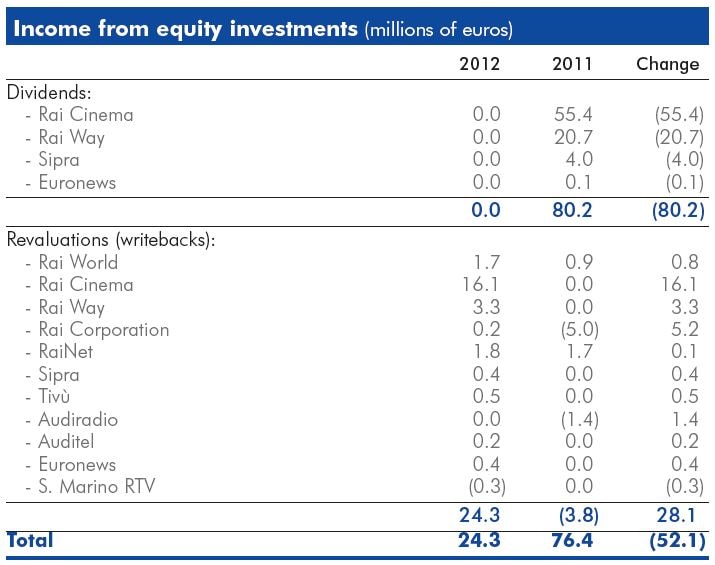
Net exceptional expense
This item amounts to 48.8 million euros
(4.8 million euros in 2011) and refers
mainly to costs sustained for actions to
incentivise early staff resignation (62.2
million euros) partially offset by the gain
from the reimbursement of IRES
(corporate income tax) for the full
deductibility of IRAP (regional tax on
production) relating to personnel costs
and similar (12.8 million euros).
Income taxes
The item amounts to 1.7 million euros
(8.2 million euros in 2011), determined
by the balance between current and
deferred taxes, as detailed in the table.
As regards the IRES tax, no amount was
booked as the year’s result for tax
purposes was negative.
IRAP, amounting to 25.0 million euros,
shows a decrease of 11.0 million euros
compared with the previous year,
determined by a lower taxable base.
Deferred tax liabilities determine a positive
effect of 3.0 million euros (2.7 in 2011),
as a consequence of the reversal of the
temporary differences of income deriving
from the higher amortisation applied in
previous years for tax purposes only.
Deferred tax assets (20.3 million euros)
originated from the booking of IRES
credit deriving mainly from:
• the negative taxable amount, which
was offset by the positive taxable
amounts of the subsidiaries, included
within the scope of consolidation for
the 2012 tax year, with a positive tax
effect of 13.3 million euros;
• newly booked temporary differences
for programme assets, which we are
sure will be recovered in that they are
transformable into tax credits, as
provided for by paragraphs 55, 56
and 56 bis of Law Decree 225/2010,
as amended by Law Decree
201/2011, with a positive tax effect
of 8.1 million euros.

Balance sheet
Non-current assets
Tangible non-current assets, which
have remained largely stable, are
detailed in the table below.
Investments in programmesare
mainly represented by TV fiction series
(291.9 million euros), which accounted
for the greater part of total investments
during the year (233.1 million euros).
The details are given in the table below.
Equity investments increased (+136.1
million euros) as a result of application
of the equity method to investments in
subsidiaries and associated companies,
as mentioned earlier. The details are
given in the table below.
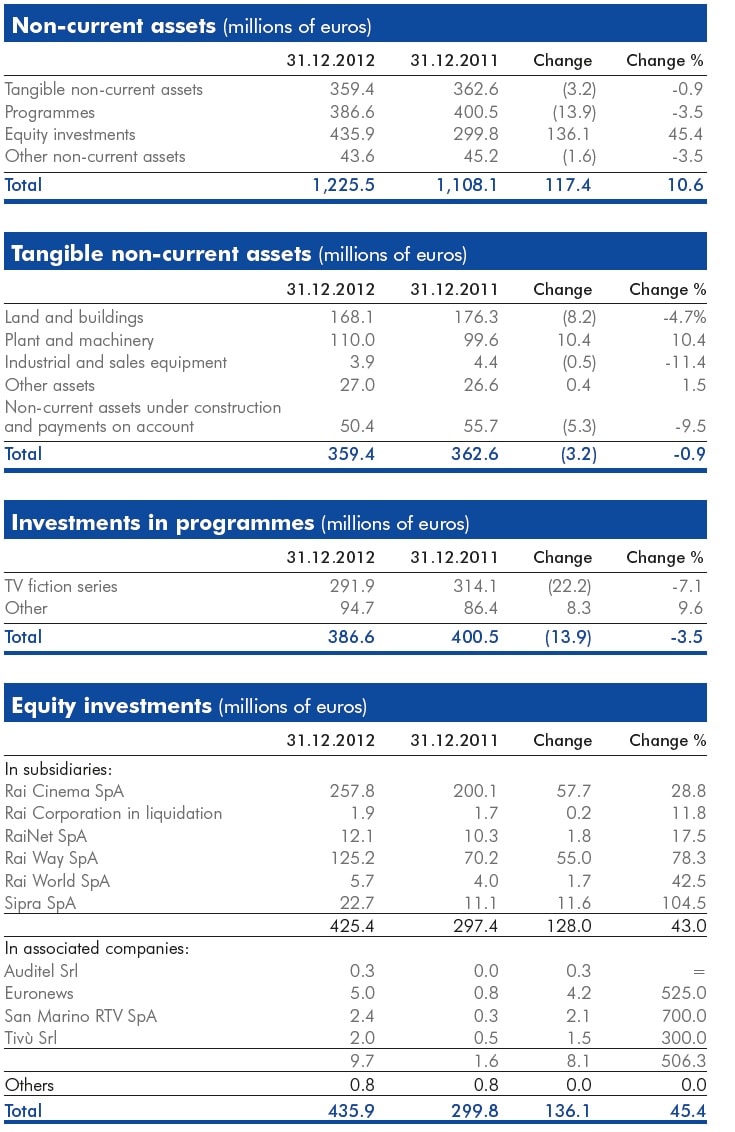
Other non-current assets, which also
remained largely stable, are detailed in
the table below.
Working capital
The change from 2011 (-134.6 million
euros) is due mainly to normal
developments in the business.
Major changes relate to:
• Trade receivables: down 214.9
million euros, due to lower amounts
of receivables from Group companies
(-124.2 million euros), mainly from
Sipra as a result of the contraction of
advertising and from minority
customers, (-90.7 million euros), the
latter determined largely by lower
receivables for special services
rendered to the Government under
contract.
• Other assets: down 65.2 million
euros largely due to the recoupment
of the advance payments made to
purchase the broadcasting rights for
sports events held during the year
(particularly the European Football
Championships and the Olympic
Games).
• Trade payables:down 187.3 million
euros, due partially to lower debts
towards subsidiaries and partially to
certain previous year’s accounts
payable to suppliers for the purchase
of sports broadcasting rights and the
DEAR property complex.
It should be noted that Trade
receivables consist mainly of accounts
receivable from subsidiaries, mainly
Sipra, and from public entities and
institutions.
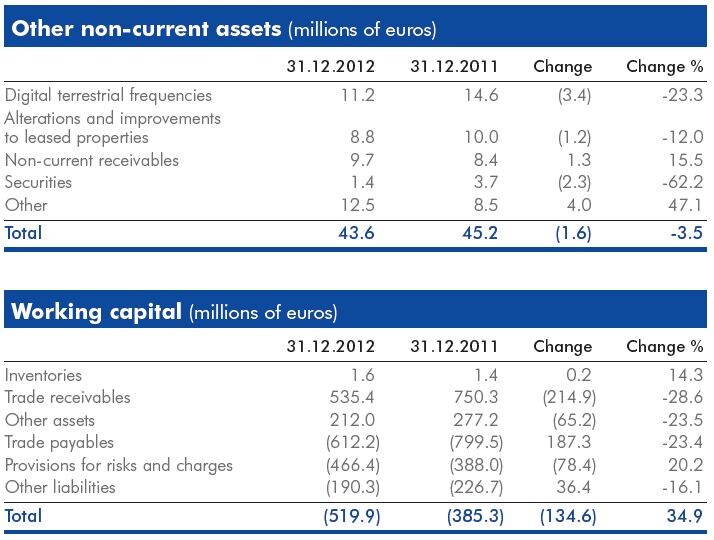
Net financial position
The year-end net financial position is
negative by 122.7 million euros,
deteriorating compared to 2011
(positive by 0.8 million euros), and is
made up as indicated in the table
below.
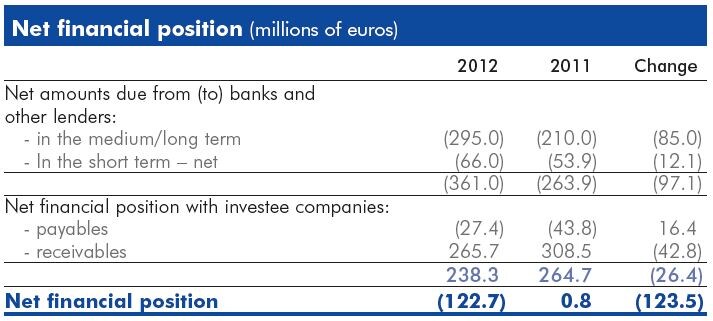
There was an increase in the amount
payable to banks (about 97 million
euros) and a reduction in the balance of
receivables from intercompany accounts
(about 26 million euros).
The growth of debt was caused by a
flow of activity during the year which,
due to the negative economic result, was insufficient to cover the
requirements determined by the year’s
investments. The latter include the
payment of the second instalment for
purchase of the DEAR property complex
(34 million euros).
In relation to cash flows for the year:
• the negative flows are due to the
considerable reduction in advertising
revenues, the absence of dividends
from the subsidiaries and the
application of previous charges
relating to the development of the
digital terrestrial network by Rai Way;
•the positive flows relate to the recovery
of amounts receivable for special
services rendered to the Government
under contract and the limitation of
the outlays to third parties outside the
Group for current expenses.
The unsecured loan of 295 million
euros taken out as part of a pool
envisages the respect of two
parametric/equity ratios, to be
calculated on the figures of the
consolidated financial statements, and
these ratios were respected.
The average net financial position is
negative by 55 million euros (positive by
18 million euros in 2011), with a
deterioration of 73 million euros which
is more limited than the final figure,
which reflects the more favourable
breakdown of the fee instalments,
consequential to the 100 million
increase in the amount paid with the
second and third instalments.
The analysis carried out on the basis of
the balance sheet and income
statement ratios highlighted that:
• the net invested capital coverage
ratio, determined in the ratio
between net invested capital and own
means, is 1.42 (1.00 in 2011);
• the current ratio, identified as the
ratio between current assets (inventories, current assets, cash and
cash equivalents and financial
receivables) and current liabilities
(current liabilities and financial debts),
is 1.13 (1.19 in 2011);
• the self-coverage ratio of noncurrent
assets, calculated as the
ratio of shareholders’ equity to noncurrent
assets, is 0.24 (0.39 in 2011).
The financial risks to which the
Company is exposed are monitored
using appropriate computerised and
statistical instruments. A policy regulates
financial management in accordance
with best international practices, the aim
being to preserve the corporate value by
taking an adverse attitude towards risk,
pursued via active monitoring of the
exposure and the implementation of
suitable hedging strategies, also acting
on behalf of the Group companies.
In particular:
• The exchange risk is significant in
relation to the exposure in US dollars
generated by the acquisition of sports
events rights. These commitments
generated payments for about 65
million dollars during 2012.
Operation takes place from the date
of subscription to the commercial
commitment, often lasting several
years, and aims to defend the
counter value in euros of
commitments estimated at the time of
order or in the budget. Hedging
strategies are implemented using
financial derivative instruments – such
as forward purchases, swaps and
options– without ever taking on an
attitude of financial speculation. The
Company policy envisages operating
limits to be observed by the hedging
activity.
• The interest rate risk is also
regulated by the Company policy,
particularly for medium/long-term
exposure with specific operating limits. In relation to the medium-term
loan described above, Interest Rate
Swap agreements were entered into
during 2011 for 205 million euros,
with the aim of transforming the cost
of the loan, issued at floating rate
and therefore subject to market
volatility, to fixed rate.
• The credit risk on cash deployment
is limited in that the Company policy
envisages the use, for limited periods
of cash surpluses, of low-risk financial
instruments with parties with high
ratings. Only tied deposits or sight
deposits with remunerations close to
the Euribor rate were used during
2012.
• As regards the liquidity risk, the
Company has, in the medium term, a
loan, taken out as part of a pool, for
295 million euros (expiring in 2015),
with six-monthly amortisation as of
2013. With the banking system,
short-term and reversible credit lines
were opened for a maximum amount
of about 450 million euros. Stand-by
loans are also in place for a total of
90 million euros, maturing in
February 2013. The existing loans
allow coverage of overdrafts during
the year, on condition that payment
of the fees by the Ministry of the
Economy and Finance takes place in
observance of the contractual
quarter-end deadlines. A specific
long-term loan of 100 million euros
was taken out with the European
Investment Bank to provide further
coverage of the requirements of the
progress of the DTT project during
the year. This loan will be disbursed
in two instalments during 2013.
           |
 |